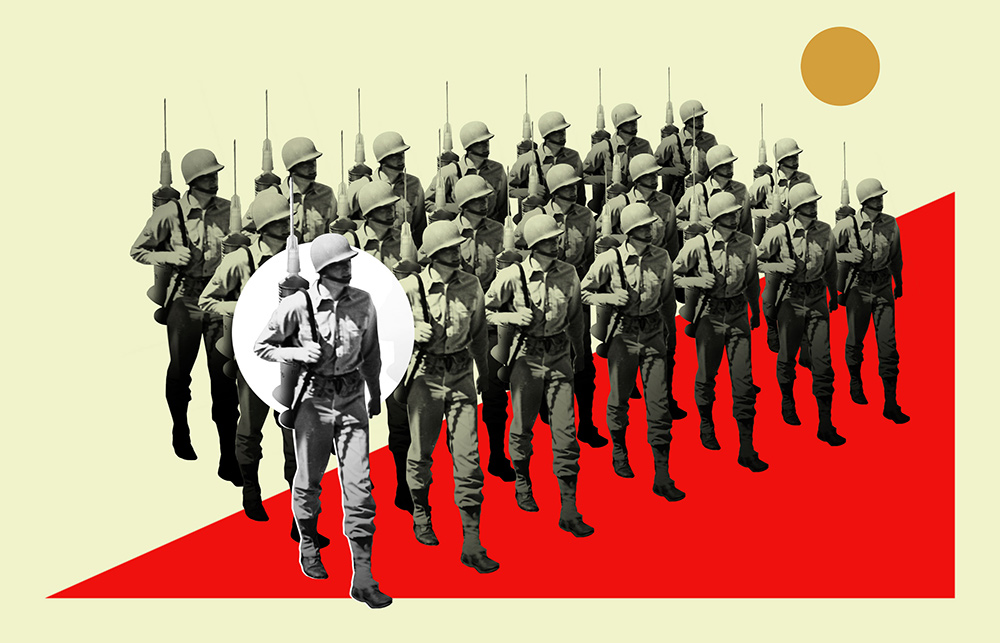
抗击新冠疫情的战役与其他战争不同,因为敌人是无形的,没有人性可言,也没有军队、将军或致命的武器,而且因为其微小的形态更具隐蔽性。然而就其经济影响而言,全球在抗击新冠疫情期间所面临的痛楚在某些方面与此前的战争有些相似,尽管并非完全一样。随着各国开始重启其经济,历史可以为今后可能会遇到哪些问题提供有用的线索,包括恢复速度、潜在的赢家和输家,以及政府角色的变化。
当前的经济形势类似于两场世界大战的全民动员,只不过这一次是逆向动员,也就是动员大家待在家中,顶着失业的风险放弃薪酬,而不是入伍上前线。
政府也加大了支出,用于资助这一逆向动员,例如直接或通过雇主给工人发钱,就像给战争中的战士开饷一样。在欧洲经济五强中,有3000多万名暂时休假的员工依然能拿到部分或全部薪酬,而这部分资金来自于政府给公司的补贴。在美国,《新冠病毒援助、救济和经济安全法案》中有近半的方案都包括直接给家庭发的资金、提升失业补助以及保护在岗员工的薪资。这场居家动员的总成本达到了约1.23万亿美元,占美国GDP的6%,与1941年美国军费占GDP的比重相当。
在两次世界大战中,政府成为了经济的主要参与方和购买者,尽管此次危机还没有发展到这个地步,但毋庸置疑的是,政府发挥的作用已经有了大幅提升。对英格兰银行千年数据集的分析显示,在一战伊始,英国政府的消费额从1913年占GDP的8%跃升至1917年的近40%。在二战中,美国政府的消费水平从1940年占GDP的15%跃升至1943年的占GDP的48%。
首先,如今的公共债要高得多,各大央行大幅提升了其资产额。美国联邦资产负债从2019年的约4万亿美元跃升至7.1万亿美元。在欧洲,央行资产亦出现了急剧增长,在近几个月中从约8000亿欧元(约合8870亿美元)升至5.5万亿欧元(约合6.1万亿美元)。众多国家政府钱袋的膨胀程度已经达到了二战末的水平。然而,如果这样的战时经济持续一个季度以上或两个季度,那么GDP的增值将依赖于政府消费的增长,因为家庭会削减消费开支,企业会削减投资,同时出口也将下滑。
与此前战争类似的是,各大领域都有可能出现明显的赢家和输家。资源在战时会迅速地从一个领域流入另一个领域。各国政府会努力发展任何战略性产业,从坦克一直到食品。与此同时,依赖于家庭可自由支配开支的各大领域将降低其产能。例如,美国劳工部的数据分析显示,在1941年至1944年期间,美国城市家庭在家庭装饰、电器、休闲和娱乐方面的开支减少了25%。同样在疫情期间,一些受封锁令影响的领域遭受的经济损失要大得多,例如交通、娱乐和休闲,以及酒店行业。
但这种战争类比并不总是能够站得住脚。在两次世界大战期间,各国均通过加大动员力度来驱除经济中的各种萧条因素,结果造成了劳动力市场的紧张以及通胀的攀升。失业基本上消失了。如今我们很难想象,自疫情爆发以来大多数申请失业救助的3300万美国工人以及法国、德国、意大利、西班牙和英国3000万暂时休假的工人,能够通过这种方式来解决就业问题。反而,各国可能会迎来半常态化的局面,其中,差旅和酒店行业将处于超低负荷运转状态,破产和财务困境依然会持续,而且有关新一波感染的担忧依然会存在。
这场战争是否会以经济萧条告终?这正是美国在两次世界大战、美国内战以及朝鲜战争结束后遇到的情况。在政府消费迅速萎缩的同时,家庭收入的增长还不足以支撑经济的发展。这一次,疫情后经济放缓的某些诱因种子已经种下。政府会收回其超常的财政手段,而提升公共债务可能会引发担忧、裁员和紧缩。如果失业率依然居高不下,家庭开支的恢复可能需要很长的时间。
这场疫情给数千万民众带来了经济不安感。不过,如果我们能够以历史为鉴,那么随之而来的就会是社会改革。英国、法国和其他一些欧洲国家在二战期间或结束后开展了重大的福利制度改革。在美国,《退伍军人法》为告老还乡的士兵提供了提升其技能和教育程度的机会。因此,疫情后的恢复可能会加速这些变化,例如基本收入、远程工作以及家庭、员工和公司在供应链中弹性的增加。如果这类变化发生了,我们的社会契约可能将得到更新,它将改善收入保障,提供更多接触科技的机会,并将生产力和经济繁荣不断推向新高度。(财富中文网)
加里·平库斯是麦肯锡北美的董事长。
斯里·拉玛斯瓦米是麦肯锡全球研究所的合伙人。
译者:Feb
抗击新冠疫情的战役与其他战争不同,因为敌人是无形的,没有人性可言,也没有军队、将军或致命的武器,而且因为其微小的形态更具隐蔽性。然而就其经济影响而言,全球在抗击新冠疫情期间所面临的痛楚在某些方面与此前的战争有些相似,尽管并非完全一样。随着各国开始重启其经济,历史可以为今后可能会遇到哪些问题提供有用的线索,包括恢复速度、潜在的赢家和输家,以及政府角色的变化。
当前的经济形势类似于两场世界大战的全民动员,只不过这一次是逆向动员,也就是动员大家待在家中,顶着失业的风险放弃薪酬,而不是入伍上前线。
政府也加大了支出,用于资助这一逆向动员,例如直接或通过雇主给工人发钱,就像给战争中的战士开饷一样。在欧洲经济五强中,有3000多万名暂时休假的员工依然能拿到部分或全部薪酬,而这部分资金来自于政府给公司的补贴。在美国,《新冠病毒援助、救济和经济安全法案》中有近半的方案都包括直接给家庭发的资金、提升失业补助以及保护在岗员工的薪资。这场居家动员的总成本达到了约1.23万亿美元,占美国GDP的6%,与1941年美国军费占GDP的比重相当。
在两次世界大战中,政府成为了经济的主要参与方和购买者,尽管此次危机还没有发展到这个地步,但毋庸置疑的是,政府发挥的作用已经有了大幅提升。对英格兰银行千年数据集的分析显示,在一战伊始,英国政府的消费额从1913年占GDP的8%跃升至1917年的近40%。在二战中,美国政府的消费水平从1940年占GDP的15%跃升至1943年的占GDP的48%。
首先,如今的公共债要高得多,各大央行大幅提升了其资产额。美国联邦资产负债从2019年的约4万亿美元跃升至7.1万亿美元。在欧洲,央行资产亦出现了急剧增长,在近几个月中从约8000亿欧元(约合8870亿美元)升至5.5万亿欧元(约合6.1万亿美元)。众多国家政府钱袋的膨胀程度已经达到了二战末的水平。然而,如果这样的战时经济持续一个季度以上或两个季度,那么GDP的增值将依赖于政府消费的增长,因为家庭会削减消费开支,企业会削减投资,同时出口也将下滑。
与此前战争类似的是,各大领域都有可能出现明显的赢家和输家。资源在战时会迅速地从一个领域流入另一个领域。各国政府会努力发展任何战略性产业,从坦克一直到食品。与此同时,依赖于家庭可自由支配开支的各大领域将降低其产能。例如,美国劳工部的数据分析显示,在1941年至1944年期间,美国城市家庭在家庭装饰、电器、休闲和娱乐方面的开支减少了25%。同样在疫情期间,一些受封锁令影响的领域遭受的经济损失要大得多,例如交通、娱乐和休闲,以及酒店行业。
但这种战争类比并不总是能够站得住脚。在两次世界大战期间,各国均通过加大动员力度来驱除经济中的各种萧条因素,结果造成了劳动力市场的紧张以及通胀的攀升。失业基本上消失了。如今我们很难想象,自疫情爆发以来大多数申请失业救助的3300万美国工人以及法国、德国、意大利、西班牙和英国3000万暂时休假的工人,能够通过这种方式来解决就业问题。反而,各国可能会迎来半常态化的局面,其中,差旅和酒店行业将处于超低负荷运转状态,破产和财务困境依然会持续,而且有关新一波感染的担忧依然会存在。
这场战争是否会以经济萧条告终?这正是美国在两次世界大战、美国内战以及朝鲜战争结束后遇到的情况。在政府消费迅速萎缩的同时,家庭收入的增长还不足以支撑经济的发展。这一次,疫情后经济放缓的某些诱因种子已经种下。政府会收回其超常的财政手段,而提升公共债务可能会引发担忧、裁员和紧缩。如果失业率依然居高不下,家庭开支的恢复可能需要很长的时间。
这场疫情给数千万民众带来了经济不安感。不过,如果我们能够以历史为鉴,那么随之而来的就会是社会改革。英国、法国和其他一些欧洲国家在二战期间或结束后开展了重大的福利制度改革。在美国,《退伍军人法》为告老还乡的士兵提供了提升其技能和教育程度的机会。因此,疫情后的恢复可能会加速这些变化,例如基本收入、远程工作以及家庭、员工和公司在供应链中弹性的增加。如果这类变化发生了,我们的社会契约可能将得到更新,它将改善收入保障,提供更多接触科技的机会,并将生产力和经济繁荣不断推向新高度。(财富中文网)
加里·平库斯是麦肯锡北美的董事长。
斯里·拉玛斯瓦米是麦肯锡全球研究所的合伙人。
译者:Feb
The war against COVID-19 is unlike other wars in that the enemy is invisible and inhuman, without armies, generals, or deadly hardware, and all the more insidious for being microscopic. Yet in terms of its economic consequences, the global struggle against the coronavirus does resemble previous wars in some—but not all—respects. As countries tackle reopening, history can provide helpful clues about what to expect next, in terms of the speed of recovery, potential winners and losers, and the changed role of government.
The current economic cycle is similar to the mass mobilization of the two world wars. This time, though, the mobilization is happening in reverse, an at-home mobilization of residents being asked to stay home, forgo paychecks, and risk unemployment rather than enlist to fight.
Government spending has ramped up to finance this reverse mobilization, paying workers directly or through their employers, just as it did soldiers in war. Across Europe’s five largest economies, more than 30 million furloughed workers continue to receive much or all of their pay via government subsidies to companies. In the United States, roughly half the Coronavirus Aid, Relief, and Economic Security (CARES) Act package includes direct payments to households, expanded unemployment benefits, and paycheck protection for employed workers. This at-home mobilization, which totals to about $1.23 trillion, amounts to nearly 6% of U.S. GDP—roughly the U.S. military budget’s share of GDP in 1941.
Government during the two world wars became the primary actor and purchaser in the economy—and while that isn’t yet the case in this crisis, its role has certainly grown substantially. At the start of the First World War, government consumption in Britain jumped from 8% of GDP in 1913 to nearly 40% in 1917, according to analysis of the Bank of England’s millennium data set. During the Second World War, America’s government consumption rose from 15% of GDP in 1940 to 48% by 1943.
Public debt today is much higher to begin with, and central banks have massively increased their assets. The U.S. federal balance sheet jumped from about $4 trillion in 2019 to $7.1 trillion, and in Europe, central bank assets have also risen sharply, increasing in recent months by around 800 billion euros ($887 billion) to 5.5 trillion euros ($6.1 trillion). The public purse is thus already as stretched in many countries as it was at the end of the Second World War. Yet, if this wartime economy continues for more than one or two quarters, growth in government consumption is what will keep GDP growth going as households cut back on consumption, businesses cut back on investment, and exports fall.
As in previous wars, there are likely to be clear winners and losers among sectors. Resources move quickly from one area to another in wartime. Governments call the shots for anything deemed strategic, from tanks to food. Meanwhile sectors that depend on households’ discretionary spending could see a fall in output; between 1941 and 1944, for instance, urban American households reduced their spending on household furnishings, appliances, recreation, and entertainment by 25%, according to analysis of data from the U.S. Bureau of Labor Statistics. Likewise, during this pandemic, economic loss has been disproportionately in sectors affected by the lockdowns, like the transportation, entertainment and recreation, and hospitality industries.
The war analogy does not always hold up. During the two world wars, mobilization ramped up to absorb all the slack in the economy, tightening the labor market, and raising inflation. Unemployment essentially disappeared. Today, it is hard to imagine that most of the 33 million U.S. workers that filed for unemployment since the pandemic spread or the 30 million furloughed workers in France, Germany, Italy, Spain, and the U.K. will be absorbed by mobilization. Instead, countries may settle for a half-normal situation, one in which travel and hospitality operate well below capacity, bankruptcies and financial hardships continue at a steady pace, and persistent worries remain about a new wave of infections.
Could this war end with a recession? That is what happened in the U.S. after both world wars, the American Civil War, and the Korean War. While government consumption shrank quickly, households did not have the income growth to step up as economic engines. This time, some of the conditions for a post-pandemic slowdown have already been seeded. Governments will pull back their extraordinary fiscal measures, and rising public debt could trigger concerns and calls for cutbacks and austerity. Household spending may take time to recover if unemployment continues to be high.
This pandemic has highlighted the economic insecurity of millions. But if the past is a guide, social reforms could follow. In Britain, France, and some other European countries, major welfare reforms were enacted during or at the end of the Second World War. In the U.S., the GI Bill gave returning soldiers an opportunity to upgrade their skills and education. Thus, the post-pandemic recovery could potentially accelerate changes such as universal incomes, remote work, and greater resilience for households, workers, and companies in supply chains. If such changes are enacted, we could end up with a renewed social contract that improves income security, expands access to technology, and creates a rising tide of productivity and economic prosperity.
Gary Pinkus is chairman of North America for McKinsey.
Sree Ramaswamy is a partner at the McKinsey Global Institute.






